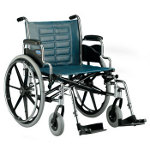The Wheelchair Guide
Your Wheelchair and Mobility Scooter Resource
Manual Wheelchairs Explained
Wednesday, September 2nd, 2009 at 9:34 am
 The wheelchair has been used in some shape or form for thousands of years, however over the last 100 years, the technology behind the wheelchair has been greatly improved and a standard created for manual wheelchairs. Despite the increasing popularity of electric wheelchairs, manual wheelchairs remain to be the most popular mobility vehicle used by those who have difficulty walking.
The wheelchair has been used in some shape or form for thousands of years, however over the last 100 years, the technology behind the wheelchair has been greatly improved and a standard created for manual wheelchairs. Despite the increasing popularity of electric wheelchairs, manual wheelchairs remain to be the most popular mobility vehicle used by those who have difficulty walking.
Manual Wheelchair Basics
The manual wheelchair of today is based off of the E&J manual wheelchair design, which was first developed and sold during the 1930′s. Most use hollow steel tubes, or another light but durable metal, for the frame of the wheelchair.
The frame is designed in a manner that allows it to be folded up when not in use, allowing a manual wheelchair to be placed into the trunk of a car. By using the lightweight metal, it is often possible for the wheelchair user to transfer into a car or van, putting up their wheelchair without assistance.
The seat is most often made out of thin piece of vinyl that attached to the frame securely with stitching. Other fabrics are available and becoming more popular, with stain resistant breathable materials being very popular. Since the seat and backrest are made out of a thin piece of fabric, it does not get in the way when the wheelchair is folded up.
Footrests extend from the front of the wheelchair and are attached to the frame of the wheelchair. The footrests can often be removed from the frame completely or folded when not in use, making it easier to transfer into and out of the wheelchair. The footrests and the bars that hold them in place are referred to as the front rigging.
Self Propelled Wheelchairs vs Transport Chairs
Self propelled manual wheelchairs have large rear wheels and smaller front wheels. The large rear wheels have a rim that surrounds them, allowing the wheelchair user to grasp the rim and turn the rear wheels. This allows the wheelchair to be moved and turned, but does not require the person touch the part of the wheel that makes contact with the ground, which would be unsanitary, or risk tangling their hands in the wheels spokes.
Transport wheelchairs, on the other hand, have four sets of smaller wheels, because they are designed to be pushed by a caregiver and not self propelled. Two handle bars extend from the top of the seat, allowing a caregiver to walk behind the transport wheelchair and push its occupant.
Many self propelled wheelchairs also have handlebars for caregivers, but this is not always the case, especially on sports wheelchairs.
Anti-Tip Casters
To help prevent falls and the wheelchair tipping over, anti-tip casters are usually installed on the rear of the wheelchair frame. The anti-tip casters are designed so that if the wheelchair is tipped back far enough, the casters make contact with the ground and keep the wheelchair from completely tipping over.
Anti-tip casters are found on most other kinds of mobility vehicles as well, including mobility scooters and electric wheelchairs.